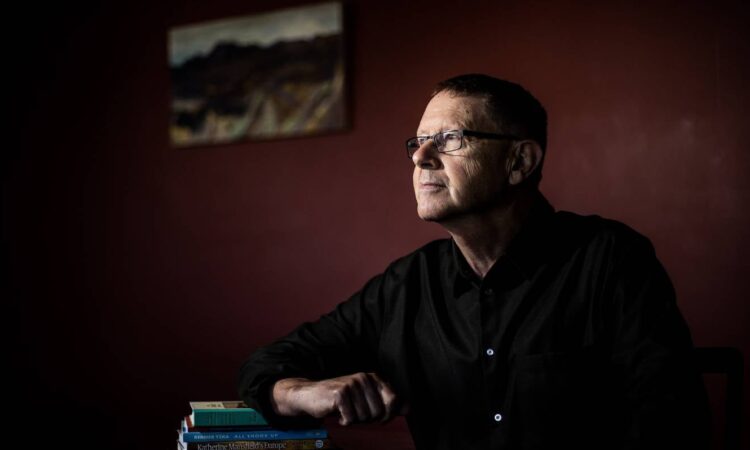
Redmer Yska woke up in the wee hours in an old Bavarian convent-turned-spa to find an 84-year-old nun at his bedside.
Instructed to disrobe for his therapeutic ‘over body wash’, he groggily complied.
He’s pretty sure writer Katherine Mansfield had had the same experience more than a century ago. It was a therapy – being washed limb by limb – she had mocked her fellow guests having at the spa in her short story collection, In A German Pension, published in 1911.
This strange episode is one of many in Yska’s book on Mansfield in which he follows in her footsteps around the Continent, using her letters and diaries as his maps. It is his second biographical offering on one of our most celebrated writers.
READ MORE:
* A centenary on from her death, Katherine Mansfield’s remembered in her hometown
* Katherine Mansfield’s love letters published in new book
* Karen Walker helps raise funds for Katherine Mansfield House & Garden
* Katherine Mansfield museum honours life of artist Edith Robison
Mansfield gave a ‘wonderful spine’ in her letters for the book, he says.
“I swallowed those letters. I really absorbed them and realised what an absolute rich treasure trove they are. They became like my maps.
“It was like going to the well of her life.”
Yska, an author and historian, went to some lengths to follow the ghost of KM – or Katherine, as he calls her; the pair are on a one-sided first name basis.
Supplied
Portrait of Katherine Mansfield by Anne Estelle Rice (Te Papa Collection)
On his travels he finds a chain-smoking, gunslinging, drug-taking card-playing writer on a desperate bid to outrun the illness that was slowing consuming her; a writer of luminous talent, a woman prone to obsession, and in a gut-wrenching moment, a vile racist rant.
During much of the book we find Mansfield on a quest to find a cure or at least treatment for her tuberculosis ,writing some of her most highly regarded short stories at her lowest points.
Yska wanted to track the writer’s movements during her European epoch right to her last stop, Fontainebleau, southeast of Paris, where she was finally consumed by the disease that blighted her final six years.
DAVID UNWIN/Stuff
Redmer Yska researched his second Mansfield book during three trips to Europe supported by a Creative New Zealand grant of $60,000.
And so the end was where he began – at the very place she took her last lung-rattling breaths.
It is at a large commemorative rock in the forest nearby that he starts his part pilgrimage, part travelogue, part reportage on Mansfield in the company of one of the writer’s biggest devotees: Bernard Bosque.
The Frenchman, who faithfully tends Mansfield’s tomb and holds annual graveside birthday commemorations, was one of many ‘historians, literary sleuths and shameless admirers’ of Mansfield to have helped Yska on his search for nuggets of gold on the writer’s European life.
ANDREAS KLEMM/Supplied
Katherine Mansfield’s iron statue in Cure Park, Bad Wörishofen in Germany.
His book, Katherine Mansfield’s Europe, Station to Station, is a gallop around the Continent chasing up leads on her life and work.
Travelling by train, as Mansfield did, he filled up his A5 notebooks with his own experiences on that trail, from France to Germany, from Italy to Switzerland and ultimately, back to Fontainebleau, picking up her traces like a literary bloodhound.
Trying to say something new about Mansfield was like trying to say something new about Tuesday, Yska says.
He took his lead in this new book from his ‘hero’ biographer Richard Holmes.
“You have to go in the footsteps. To understand these people you’ve got to go to the places where they lived. You have to get out from behind the typewriter and get out there.”
Supplied
Katherine Mansfield spent many years living and working in Europe.
Much has been written about Mansfield but not so much on her European years, says Wellington-based Yska.
He also wanted to look at her celebrity status in France – she was embraced by her own country only much later.
“We didn’t value writers,” he says. “It was a very male world and she was writing this language of feeling and emotion.
“We were really behind the eight-ball on it … We only valued soldiers, All Blacks, farmers. We didn’t value a Bohemian woman.”
It wasn’t till 1957 when New Zealand Government bought her papers, we actually value a writer, he says.
There is a spotlight on her frantic search for treatment, and ultimately a cure for her consumption as she travelled from the South of France to the Swiss Alps for friendlier climes, better air.
Funded with a $60,000 Creative New Zealand grant, Yska researched the book over three trips to Europe between 2017-2019 – conveniently before the pandemic shut the world down.
DAVID UNWIN/Stuff
Redmer Yska says his research on Mansfield in Europe was assisted by many devotees of the writer.
Yska’s palpable excitement bounces off the pages when he visits places she’s lived and written, the restaurants and hotels she frequented on her own, and with husband John Middleton Murry.
In the south Bavarian town of Allgäu he finds records of the little boy Walter whom she helped nurse back to health following the stillbirth of her own child and from whom she is suspected of contracting tuberculosis.
In the same town he finds photos of the German man who would later appear as a character in her short story collection In A German Pension.
He visits places where she is immortalised, finding statues, roads, squares, even an apartment complex using her name as a selling point.
He visits the Victoria Palace Hotel in Paris where Mansfield and Murry stayed. Yska talks emotionally as he describes looking out of the same window where she observed her neighbours daily, barely able to move as she convalesced from the gruelling radiotherapy treatment she endured in another attempt at a cure.
He even travelled to some of the places where she received treatment.
Supplied
Katherine Mansfield with her second husband John Middleton Murry.
Yska writes about Mansfield’s addiction to her notorious ‘red cough mixture’, containing both hydrobromic acid and morphine – a stronger drug than opium.
He understood Mansfield’s addiction trauma from his own experience with drug addiction and subsequent sobriety a lifetime ago in the 1970s.
Other, lesser known titbits are given some airtime.
She was a gun slinger, ‘packing iron’ as a way to protect herself after she was tossed out from her accommodation because of her TB, he says.
“I was really interested in this because it shows another side of her. The minute we see Katherine Mansfield with a gun in her hand we see her differently.
“What I love to think about with this book is that we might bring her out from behind the desk, from behind the ink pot and see her as a snooker player, as knitter, as a card player, a walker and so much more than that bookish woman we know.”
In one moment, a racist tirade from Mansfield leaves a bitter taste. “Those comments were very much of the time,” says Yska, but were “inexcusable” nevertheless.
Mansfield often comes across as difficult. In a particularly drug-addled moment she writes of her desire to kill her companion Ida Baker, who is caring for her in her ill health. Baker, the most constant person in her life and possibly Mansfield’s lover at one point, supported the writer financially, physically and emotionally for years.
Supplied
Villa Isola Bella (Katherine Mansfield writing room) in Menton, South of France, where Mansfield lived and worked during her illness.
Threading through the book are nuggets from Paris reporter Roland Merlin’s 1950 biography of Mansfield.
Yska, a former journalist himself, says it was Merlin’s biography that helped him ‘decode’ France’s unique relationship with Mansfield.
“He was a ‘gumshoe’ – a proper detective. He put out the shoe leather on actually going to the places she went and that was very valuable stuff for my purposes.”
You wonder if Yska and Mansfield might have been friends had they lived at the same time.
He would probably have been a bit scared of her, he says. “She was a formidable intellect, a tough cookie, quite a hard person.
“And yet she was incredibly ill. Your heart breaks for her indomitability. She’s completely determined on getting the work done, pushing through.”
Conor Horgan/Stuff
Katherine Mansfield’s tomb in Avon, France.
Yska ends his journey where Mansfield ended hers, back at Avon near Fontainebleau.
He visits her tomb and recounts another story about her remains ending up in a nearby pauper’s grave because of Murry’s ineptness at securing her a plot in perpetuity.
It wasn’t till six years later that a tombstone was erected in her honour.
Despite stories of her being exhumed and reburied it’s unlikely the bones there are even hers, says Yska.
The epitaph reads: Katherine Mansfield – wife of John Middleton Murry – 1888-1923. In 1957, on Murry’s death, ‘Born at Wellington, New Zealand’ was added to the headstone.
The word ‘Writer’ is still absent.
Katherine Mansfield’s Europe – Station to Station (Otago University Press) is published on May 2.






